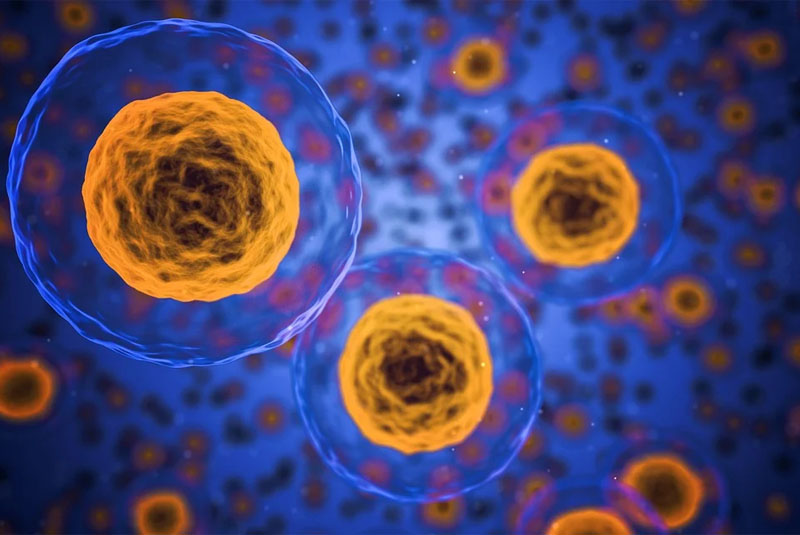PROLIFIC: Epithelial Damage

Does epithelial damage impact fibrosis?
Epithelial cells line the alveoli, or air sacs, of the lungs. These cells allow materials to pass through by diffusion and filtration. Damaged epithelial cells lose their permeable qualities, blocking the passage of air through the lungs into the blood.
According to the hypothesis of injury/repair imbalance, the body can typically heal epithelial damage—up to a point. It’s possible that either excessive injury or an inability to stop the normal repair processes may lead to lung fibrosis. More research is needed in this area.
Current studies:
KL-6/MUC-1
Krebs von den Lungen-6/Mucin 1
In a 2014 paper, Ohshimo et al. reported on a prospective cohort of 77 patients with IPF. They set out to assess the significance of KL-6 as a predictor of acute exacerbations (AEs) in IPF. They correlated baseline serum biomarker levels with later cases of AE.
The authors found that baseline serum KL-6 levels were significantly higher in patients who developed AE than in patients with stable IPF. Patients who had a baseline serum KL-6 level of 1300 U/mL or higher experienced earlier onset of AE. Additionally, baseline serum KL-6 level was an independent predictive factor for AE after adjusting for age, sex, smoking history and % vital capacity.
Why are we studying this?
Evidence of Prognostic Value for KL-6/MUC-1 was found in the following research:
Related Clinical Trials
Evaluation of Oral ORIN1001 in Subjects With Idiopathic Pulmonary Fibrosis (IPF)
FIBRotic Interstitial Lung Disease and Nocturnal OXygen (FIBRINOX)
CA-125/MUC 16
Cancer antigen 125/Mucin 16
PROFILE, a multicenter prospective longitudinal cohort of treatment-naive patients with idiopathic pulmonary fibrosis (IPF), assessed potential biomarkers to predict outcomes for people with IPF. Maher et al. performed multiplex immunoassay assessment of 123 biomarkers, then used immunohistochemical assessment of IPF lung tissue to investigate promising novel markers and their predictive power to identify patients at risk of progression or death.
The PROFILE authors identified CA-125 as one of four serum biomarkers to replicate (the other biomarkers were SP-D, MMP-7, and CA19-9). Their histological assessments suggested that both CA19-9 and CA-125 are markers of epithelial damage. They also found that rising concentrations of CA-125 over 3 months were associated with increased risk of mortality.
Why are we studying this?
Evidence of Prognostic Value for CA-125 was found in the following research:
Related Clinical Trials
It's Not JUST Idiopathic Pulmonary Fibrosis Study (INJUSTIS)
Management of Progressive Disease in Idiopathic Pulmonary Fibrosis (PROGRESSION)
Assessment of Continuous Positive Airway Pressure Therapy in IPF (ACT-IPF)
Prospective Study of Fibrosis In the Lung Endpoints (PROFILE - Central England) (PROFILE)
CA19-9
Cancer antigen 19-9
PROFILE, a multicenter prospective longitudinal cohort of previously untreated patients with idiopathic pulmonary fibrosis (IPF), assessed potential biomarkers to predict outcomes for people with IPF. Maher et al. performed multiplex immunoassay assessment of 123 biomarkers, then used immunohistochemical assessment of IPF lung tissue to investigate promising novel markers and their predictive power to identify patients at risk of progression or death.
The PROFILE authors identified CA19-9 as one of four serum biomarkers to replicate (the other biomarkers were SP-D, MMP-7, and CA-125). Their histological assessments suggested that both CA19-9 and CA-125 are markers of epithelial damage. The replication analysis showed that baseline values of CA19-9 were significantly higher in patients with progressive disease than in patients with stable disease.
Why are we studying this?
Evidence of Prognostic Value for CA19-9 was found in the following research:
Related Clinical Trials
SP-D
Surfactant Protein-D
In 2017, Wang et al. published a systematic review and meta-analysis on the impact of serum SP-A and SP-D levels on the comparison and prognosis of IPF. After identifying 21 high-quality, relevant studies, the authors compared IPF patients with healthy controls, patients with pulmonary infection and patients with non-IPF interstitial lung disease (ILD).
In response to their finding that elevated SP-D increased the risk of developing IPF by 111% when compared to low SP-D, the authors hypothesized that SP-D could provide supporting evidence for clinical history and high-resolution computed tomography (HRCT) when diagnosing IPF. SP-D levels could also potentially help clinicians distinguish IPF from other ILDs. Additionally, SP-D levels may predict which IPF patients are most at risk for acute exacerbation (AE).
Why are we studying this?
Evidence of Prognostic Value for SP-D was found in the following research:
Related Clinical Trials
CYFRA 21-1
Cytokeratin 19 fragment
PROFILE, a multicenter prospective longitudinal cohort of previously untreated patients with idiopathic pulmonary fibrosis (IPF), assessed potential biomarkers to predict outcomes for people with IPF. Maher et al. performed multiplex immunoassay assessment of 123 biomarkers, then used immunohistochemical assessment of IPF lung tissue to investigate promising novel markers and their predictive power to identify patients at risk of progression or death.
In a later exploratory analysis of the PROFILE cohort, Simpson et al. identified CYFRA 21-1 as a biomarker with the potential to identify both baseline prognosis and change over time. Higher levels of CYFRA 21-1 predicted worse outcomes among patients with IPF.
Why are we studying this?
Evidence of Prognostic Value for CYFRA 21-1 was found in the following research:
Related Clinical Trials
